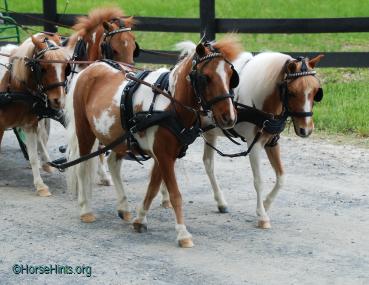 Miniature horses are found all over the world and come in various colors and coat patterns. The designation of miniature horse is determined by the height of the animal, which, depending on the particular registry involved, is usually less than 34-38 inches (86-97 cm) as measured at the withers. While miniature horses are the size of a very small pony, many retain horse characteristics and are considered "horses" by their respective registries.
Miniature horses are found all over the world and come in various colors and coat patterns. The designation of miniature horse is determined by the height of the animal, which, depending on the particular registry involved, is usually less than 34-38 inches (86-97 cm) as measured at the withers. While miniature horses are the size of a very small pony, many retain horse characteristics and are considered "horses" by their respective registries.
Miniature horses are friendly and interact well with people. For this reason they are often kept as family pets, though they still retain natural horse behavior and must be treated like an equine, even if they primarily serve as a companion animal. They are also trained as service animals, akin to assistance dogs for people with disabilities. While miniature horses can be trained to work indoors, they are still real horses and are healthier when allowed to live outdoors (with proper shelter and room to run) when not working with humans.
They are generally quite hardy, often living longer on average than some full-sized horse breeds; the average life span of miniature horses is from 25 to 35 years.
Organizations and Registration Requirements
A miniature horse working as a service animal - There are two registries in the United States for Miniature Horses, the American Miniature Horse Association (AMHA) and the American Shetland Pony Club and American Miniature Horse Registry (AMHR).
The AMHA was founded in 1978 and was dedicated to establishing the Miniature horse as a distinct breed of horse. The AMHR is a division of the American Shetland Pony Club and was established as a separate registry in 1972. In the AMHA, Miniatures cannot exceed 34 inches at the withers (which the AMHA defines as located at the last hair of the mane). There are two divisions in AMHR - the "A" division for horses 34 inches (86 cm) and under, and the "B" division for horses 34 to 38 inches (86 to 97 cm).
Worldwide, there are dozens of miniature horse registries. Some organizations emphasize breeding of miniatures with horse characteristics, others encourage minis to retain pony characteristics.
The AMHA standard suggests that if a person were to see a photograph of a miniature horse, without any size reference, it would be identical in characteristics, conformation, and proportion to a full-sized horse.
According to the AMHR, a "Miniature should be a small, sound, well-balanced horse and should give the impression of strength, agility and alertness. A Miniature should be eager and friendly but not skittish in disposition."
Miniature Horse Club Great Britain (MHCGB) is able to register and issue passports to miniature horses with 50% or more American blood, at least one parent must be registered with the AMHA. This is the only club in the UK to be sanctioned by the AMHA.
"What is the criteria for a miniature horse to be chosen for service as a Guide Horse?
Prior to acceptance into the Guide Horse training program, all miniature horses are required to pass a thorough physical examination by a licensed Equine Veterinarian. Size is also an issue, and all miniature horses must measure less than 26 inches high at the withers to enable accessibility for their blind owner. The miniature horse must also possess structurally sound legs, good health and demonstrable stamina. Only those miniature horses certified sound and healthy by the Veterinarian are accepted into the program. All Guide Horses are also tested for intelligence prior to entry into the training program. During training, the miniature horses undergo periodic physicals to ensure their continual health and soundness. The GHF only accepts mini horses that are capable of meeting the rigorous physical demands of the program. ..." Have all your questions answered by following the link provided: Guide Horses.com ![]()

